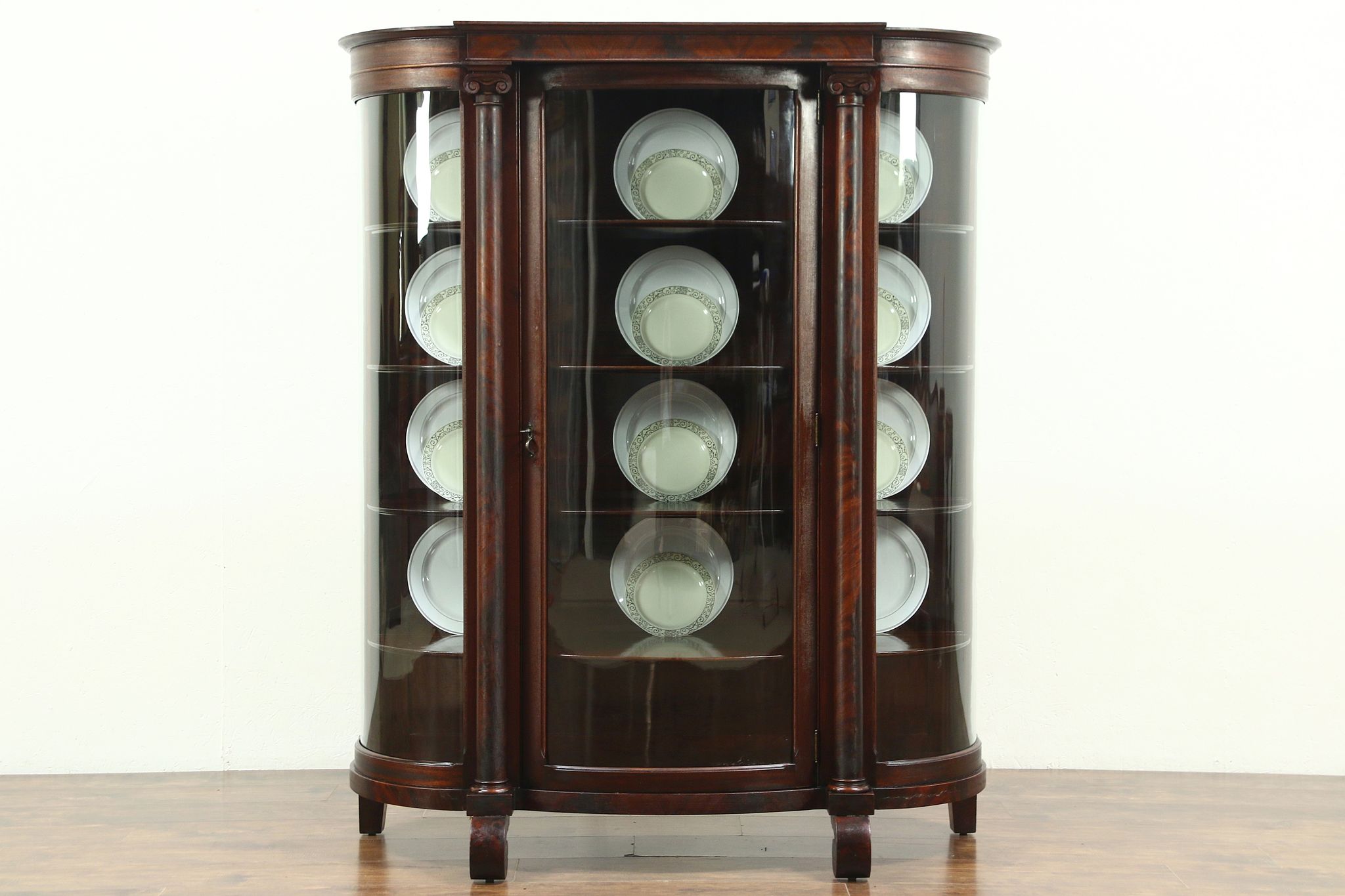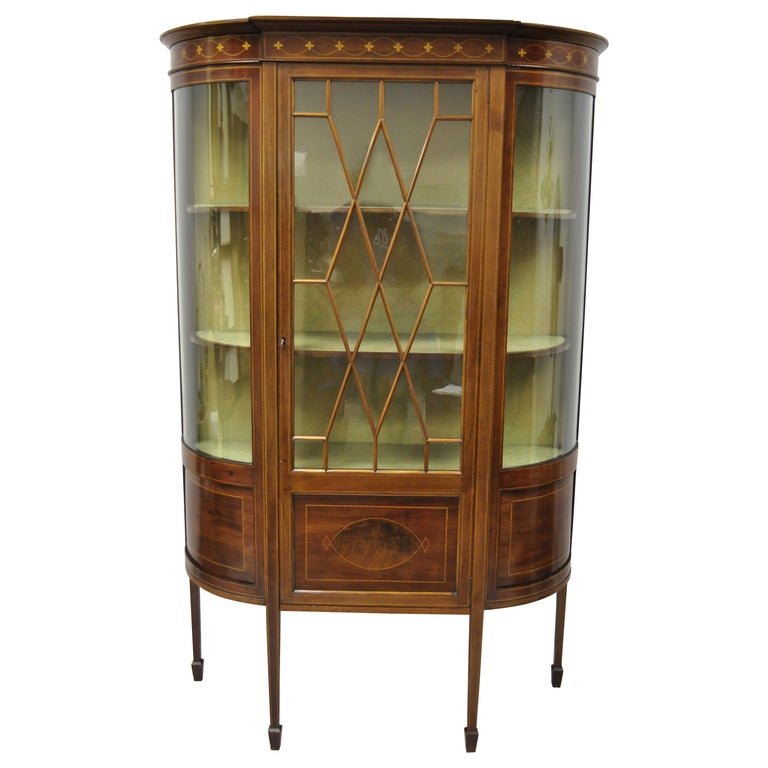The History and Evolution of Curved Glass China Cabinets

The curved glass china cabinet, a stunning testament to craftsmanship and design, has a rich history that spans centuries. From its humble beginnings to its evolution into a sophisticated statement piece, this furniture category has witnessed the interplay of technological advancements and evolving aesthetic preferences.
The Origins of Curved Glass in Furniture Design
The use of curved glass in furniture design can be traced back to ancient times. Early civilizations, such as the Romans, were known to employ glassblowing techniques to create decorative vessels and ornaments. However, the application of curved glass in furniture, particularly in china cabinets, emerged later during the Renaissance period.
The Development of Curved Glass Techniques in China Cabinets
The development of curved glass techniques for china cabinets was closely linked to advancements in glassmaking and furniture construction. During the 17th and 18th centuries, the invention of the glass cylinder method allowed for the creation of larger, more intricate curved glass panels. This breakthrough enabled furniture makers to incorporate curved glass into cabinets, showcasing the delicate contents within.
Notable Examples of Historical Curved Glass China Cabinets, Curved glass china cabinet worth
Throughout history, numerous notable examples of curved glass china cabinets have graced homes and museums.
- The Chippendale Curved Glass China Cabinet (18th Century): This iconic cabinet, designed by the renowned English furniture maker Thomas Chippendale, features elegant curved glass doors and intricate carvings. Its graceful lines and meticulous craftsmanship exemplify the high standards of furniture design during the Georgian era.
- The Victorian Curved Glass China Cabinet (19th Century): During the Victorian era, curved glass china cabinets were often embellished with elaborate ornamentation, including ornate carvings, gilded details, and stained glass panels. These cabinets served as both functional storage pieces and decorative focal points in Victorian homes.
- The Art Nouveau Curved Glass China Cabinet (Early 20th Century): The Art Nouveau movement embraced organic forms and flowing lines. Curved glass china cabinets from this period often featured sinuous curves, stylized floral motifs, and a sense of naturalism. These cabinets reflected the artistic sensibilities of the era and the growing appreciation for nature-inspired designs.
Factors Influencing the Value of Curved Glass China Cabinets

The value of a curved glass china cabinet is determined by a combination of factors, including the materials used, the quality of craftsmanship, and its condition. These elements contribute to the cabinet’s desirability and ultimately influence its worth.
Materials and Craftsmanship
The materials used in the construction of a curved glass china cabinet play a significant role in its value. Cabinets made from high-quality materials, such as solid wood, will generally be more valuable than those made from less expensive materials, like particleboard or veneer.
- Wood: The type of wood used can have a significant impact on value. For example, mahogany, cherry, and walnut are considered high-quality woods and will command higher prices. Oak is another popular choice, but it is typically less expensive than the other woods mentioned. The quality of the wood, such as its grain pattern and color, also influences value. Cabinets made from wood with a beautiful grain pattern or a rich color will be more desirable and, therefore, more valuable.
- Glass: The type of glass used in the curved glass panels also affects value. Antique cabinets often feature hand-blown glass, which is thicker and more substantial than the mass-produced glass used in modern cabinets. Hand-blown glass is also more likely to have imperfections, which can actually add to its value. Leaded glass, which is often used in antique cabinets, is also highly prized. The condition of the glass is also important, as any cracks, chips, or scratches will diminish its value.
- Hardware: The hardware used on a curved glass china cabinet, such as the hinges, knobs, and pulls, can also influence its value. Antique cabinets often feature hand-crafted hardware made from high-quality materials like brass or bronze. These pieces are often intricately designed and can be quite valuable in their own right. Modern cabinets often feature simpler hardware made from less expensive materials. The condition of the hardware is also important. Any signs of wear and tear will diminish the value of the cabinet.
Design Elements
The design of a curved glass china cabinet is another important factor influencing its value. Some key design elements that contribute to desirability and worth include:
- Style: The style of the cabinet can have a significant impact on its value. For example, Victorian, Art Deco, and Mid-Century Modern styles are all highly sought after. Cabinets in these styles are often more expensive than those in more common styles. The popularity of a particular style can also fluctuate over time, so a cabinet that was once considered desirable may not be as valuable today.
- Details: The details of the cabinet’s design can also influence its value. Intricate carvings, decorative moldings, and hand-painted accents are all highly prized. Cabinets with these features are often more valuable than those with simpler designs.
- Functionality: The functionality of the cabinet is also important. Cabinets with features like adjustable shelves, drawers, and lighting are more desirable and, therefore, more valuable. The size and shape of the cabinet can also affect its functionality and value. A cabinet that is too large or too small may not be as desirable as one that is a more appropriate size for the space.
Antique vs. Modern
Antique curved glass china cabinets are generally more valuable than modern ones. This is due to several factors, including the age of the cabinet, the quality of materials and craftsmanship, and the rarity of the piece. Antique cabinets are often made from higher quality materials and feature more intricate designs than modern cabinets. They are also more likely to be one-of-a-kind pieces, which makes them even more desirable and valuable.
- Antique: Antique curved glass china cabinets, typically those made before 1900, are often highly sought after by collectors and antique enthusiasts. These cabinets often feature intricate carvings, decorative moldings, and hand-painted accents, which contribute to their value. They may also be made from rare or high-quality woods, such as mahogany or walnut, which further increases their desirability and worth. The condition of an antique cabinet is also a critical factor in determining its value. A well-preserved antique cabinet with minimal wear and tear can be worth a considerable amount of money. However, antique cabinets that have been damaged or poorly restored can be significantly less valuable. It is important to note that the value of antique curved glass china cabinets can vary greatly depending on the specific piece, its condition, and the current market demand.
- Modern: Modern curved glass china cabinets are generally less valuable than antique ones. This is because they are often made from less expensive materials and feature simpler designs. However, some modern cabinets can be quite valuable, particularly those made by well-known designers or those that feature unique or innovative designs. The value of a modern curved glass china cabinet is also influenced by its condition, age, and popularity. A modern cabinet that is in excellent condition and is highly sought after can be worth a significant amount of money.
Curved Glass China Cabinets in Modern Design: Curved Glass China Cabinet Worth

While the traditional aesthetic of curved glass china cabinets remains cherished, contemporary designers have breathed new life into this classic form, resulting in innovative and visually striking pieces. Modern interpretations seamlessly blend functionality with artistic expression, pushing the boundaries of design and materials.
Contemporary Interpretations and Material Innovations
Modern curved glass china cabinets are characterized by a minimalist approach, often featuring sleek lines, clean silhouettes, and a focus on functionality. These pieces are designed to be both practical and aesthetically pleasing, seamlessly integrating into modern interiors.
The use of new materials and manufacturing techniques has revolutionized the design and construction of curved glass china cabinets. Here are some notable examples:
- High-tech Glass: Modern designs often incorporate high-tech glass, such as tempered glass, laminated glass, and even curved glass with integrated lighting. These advancements enhance durability, safety, and visual appeal.
- Sustainable Materials: In line with contemporary design trends, some manufacturers utilize sustainable materials, such as recycled glass or bamboo, in their construction. This reflects a growing awareness of environmental responsibility.
- Metal Accents: Metal accents, such as polished chrome or brushed stainless steel, are often incorporated to create a sleek and modern aesthetic. These accents can be used for handles, hinges, and base supports.
Unique Designs and Examples
Modern curved glass china cabinets showcase a wide range of unique designs, reflecting the diverse tastes and preferences of contemporary homeowners. Here are some examples:
- Floating Shelves: Some modern designs feature floating shelves made of tempered glass or metal, creating a sense of lightness and airiness. These shelves can be arranged in various configurations to display china and other collectibles.
- Integrated Lighting: Modern curved glass china cabinets often incorporate integrated lighting systems. These systems can be used to highlight the displayed items and create a dramatic and inviting atmosphere.
- Geometric Patterns: Some contemporary designs incorporate geometric patterns into the glass panels, creating a visually stimulating and modern aesthetic. These patterns can be achieved through etching, sandblasting, or the use of patterned glass.
- Multi-functional Designs: Modern curved glass china cabinets are often designed to be multi-functional. They can serve as a display case, a storage unit, or even a room divider.
Curved glass china cabinet worth – Curved glass china cabinets are pretty hot right now, especially vintage ones. You can find some real gems, like those old ones from the 50s. If you’re looking for something more modern, check out the abi arizona 2005 2 bedroom market.
You might be surprised at what you find! But hey, even if you’re not looking to buy, these curved glass cabinets are definitely eye candy. They add a touch of elegance to any room.
Curved glass china cabinets are totally timeless, man. They’re a classic way to showcase your favorite dishes and add a touch of elegance to your space. But if you’re looking for something a bit more modern, check out these horizontal kitchen wall cabinets with glass doors – they’re super stylish and perfect for displaying your favorite kitchenware.
Whether you go for the classic or the contemporary, make sure your cabinets are showcasing your personality!
